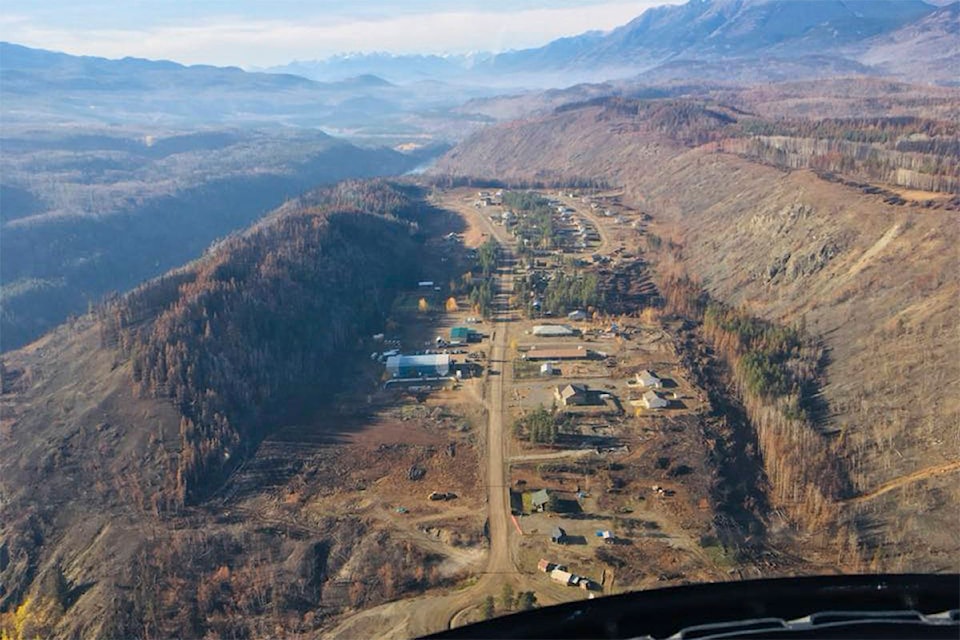While Telegraph Creek evacuees will be able to return home starting next week, life in the northern British Columbia community will never be the same, the director and recovery manager for the Tahltan Emergency Operations Centre (EOC) says.
The Tahltan Band Council announced in a Nov. 5 press release that area residents, who have been displaced since early August following an evacuation order over dangerously-close wildfires, will be able to return starting Nov. 15, with hopes of having everyone resettled by Dec. 20.
In a phone interview later on Nov. 5, Tahltan EOC director and recovery manager Feddie Louie said that while she expects returning residents to recognize Telegraph Creek, “nothing’s the same.”
“The community is burned through and it has been cleaned up … It’s hard to look at,” she said.
“Everything’s burnt. There are no trees. The machines went in and removed the trees and leveled everything because they were all burnt to the roots and most of the areas are gravel right now. There’s no greenery, there’s no shrubs … Nothing’s green there. There’s back-filled holes where homes used to be, so yeah, it’s not the same.”
The blaze that triggered British Columbia authorities to issue the evacuation order ended up growing to 120,000 hectares in size, destroying 27 buildings in Telegraph Creek including 21 homes, two businesses, a daycare and a church.
In total, more than 160 structures have been lost in the area, including fish camps, historical sites, grave sites and seasonal cottages.
Following a visit to Tahltan territory in October, federal Minister of Indigenous Services Jane Philpott wrote on Facebook that Tahltan Nation had “incurred the worst structural damage caused by wildfires of any First Nations community in recorded Canadian history.”
Louie said that clean-up and recovery work began in early September, as soon as the fires were no longer a direct threat. Crews have since repaired the water and septic systems, done engineering assessments and removed “hundreds of truckloads of debris from all different sites.”
They’ve also built an entirely new subdivision made up of 11 modular homes and renovated existing vacant structures to house some of the residents whose previous homes did not survive the fire, and three units are also available at the elders’ centre, which survived the fire.
In total, Louie said, 103 households will return to Telegraph Creek between Nov. 15 and Dec. 20, with two families choosing not to return.
Recovery efforts have been focused on ensuring that permanent, year-round residents who lost their homes will have a place to live, Louie said, while houses lost by seasonal residents will be dealt with “as need be.”
Returning residents will be allowed to returned in waves as rounds of houses are declared safe and properly cleaned of smoke damage.
Yukoners have been rallying to support evacuees since the summer, with community members holding donation drives to gather clothing, supplies and food for residents awaiting the evacuation order to be lifted. In September, two nights of Tahltan Strong fundraising concerts in Whitehorse raised more than $86,000 in support for recovery efforts.
In the Nov. 5 press release, Tahltan Band Chief Rick McLean said he was “overwhelmed with gratitude for the support the Tahltan Nation has received.”
“One of the things that I have learned is that you really see the true colours of people during a crisis. I am overwhelmed by the love and support the Tahltan Nation has received,” he said. “Thank you to all volunteers, donors and to those who have assisted.”
McLean also thanked Philpott and the federal government for their support.
“We genuinely appreciate the Minister’s effort to come to our territory and visit Telegraph Creek to witness the devastation first hand,” he said. “It really wouldn’t have been possible to begin re-entry on (Nov. 15) without our partnership with the Federal Government, who really stepped up to help meet our communities needs and get our people home as soon as possible.”
Louie said that she anticipates that while finally being allowed to go home will be a relief for many residents, it will also be difficult to return.
“I’m hoping that they have come to some place of acceptance in the last 98 days they’ve been away and counting, but I don’t think it’s going to be easy,” she said, adding that she’s in the early stages of creating a “comprehensive mental health plan” for the community covering a minimum of the next two years.
“I cannot imagine it’s going to be easy for anyone, more so for the ones who lost their homes and lost everything, to go back. But I think their heart is in the community and they need to go back there so they can start healing.”
Louie also said that, once the community settles back, planning will begin for the next fire season, with fire prevention “high on the priority list.”
But while the people and sense of community will return, Louie said that, from now on, something will always be different.
“Life will never turn back to normal in Telegraph Creek, and I say that with a heavy heart because everything has changed so much,” she said. “There has to be a new normal, and that will take a couple of years to get there. It will take awhile for our people to heal from this, to get to a place where they can accept and move on a build a new sense of community … The physical community has changed.”
Contact Jackie Hong at jackie.hong@yukon-news.com
